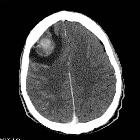Complete moles


A complete hydatidiform mole (CHM) is a type of molar pregnancy and falls at the benign end of the spectrum of gestational trophoblastic disease.
Epidemiology
A complete hydatidiform mole is the commonest type of gestational trophoblastic disease.
Pathology
Complete moles are characterized by the absence of a fetus or fetal parts (i.e. no embryonic tissues). There is a non-invasive, diffuse swelling of chorionic villi.
Chromosomal composition
Approximately 90% of complete hydatidiform moles have a 46XX diploid chromosomal pattern with ~10% having a 46XY composition. All the chromosomes are derived from the sperm, suggesting fertilisation of a single egg that has lost its chromosomes.
Markers
Serum beta HCG levels are markedly elevated, out of proportion to the pregnancy.
Radiographic features
Ultrasound
- enlarged uterus
- may be seen as an intrauterine mass with cystic spaces without any associated fetal parts
- the multiple cystic structures classically give a "snowstorm" or "bunch of grapes" type appearance.
- may be difficult to diagnose in the first trimester
- may appear similar to a normal pregnancy or as an empty gestational sac
- <50% are diagnosed in the first trimester
- bilateral theca lutein cysts may also be seen on ultrasound
- color Doppler interrogation may show high velocity with a low impedance flow
CT
CT evaluation is not usually performed due to its low resolution for the uterine assessment. CT may show an enlarged uterus with areas of low attenuation, or hypoattenuating foci surrounded by highly enhanced areas in the myometrium.
MRI
MRI may demonstrate a heterogeneous mass with cystic spaces distending the uterine cavity. Fetal parts are notably absent. Uterine zonal anatomy is often distorted although a hypointense irregular myometrial boundary may be seen .
- T1: there may be areas of high signal corresponding to foci of hemorrhage
- T2: there is heterogeneous high signal from the cystic spaces
- T1 C+ (Gd): often demonstrates intense enhancement due to hypervascularity
MRI may also demonstrate bilateral theca lutein cysts.
Treatment and prognosis
Suction and curettage are used for evacuation and are usually the routine treatment. Serial beta hCG levels are performed until it is no longer detectable on the assay, as it is the main indicator of residual disease.
A complete mole is itself benign but is considered a premalignant lesion. Degeneration into more invasive and malignant types of gestational trophoblastic disease can occur in ~10-20% of cases.
See also
Siehe auch:
- Blasenmole
- gestational trophoblastic disease
- Chorionkarzinom
- invasive mole
- ovarian theca lutein cysts
- malignant
und weiter:

 Assoziationen und Differentialdiagnosen zu complete hydatidiform mole:
Assoziationen und Differentialdiagnosen zu complete hydatidiform mole:


